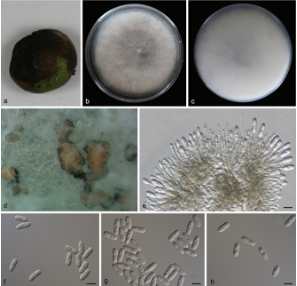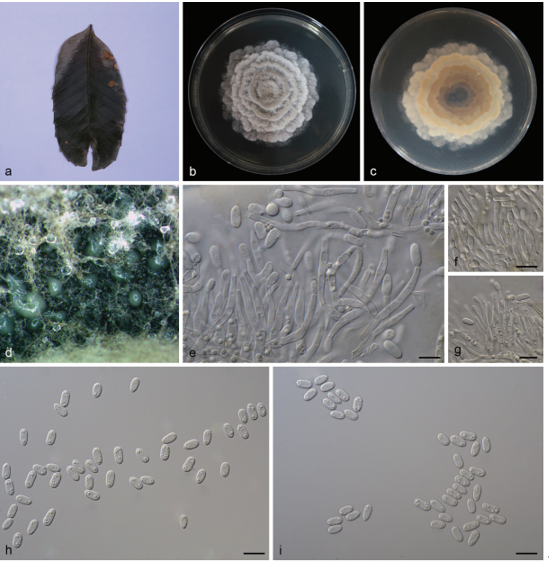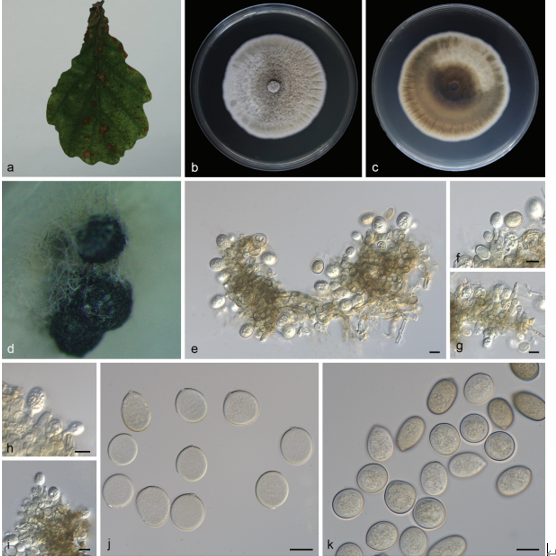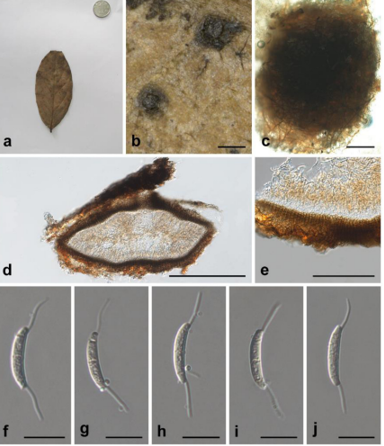Calopadia ruiliensis H.X. Wu, sp. Nov.2021
Mycobank: MB 821712.;
Sexual morph: Thallus foliicolous, dispersed or continuous, yellow greenish to creamy yellow in color, indistinct, not fluorescent under UV (366 nm); isidia and soredia absent (Figures 2a–2c). Apothecia rounded, 0.3–0.55 mm diam and 200–300 μm high; disc convex, dark brown to black and thinly pruinose; margin distinct, slightly thickened, cream-colored (Figures 2d and 2e). Excipulum 30–70 μm broad (Figure 2f). Hypothecium 25–50 μm high, dark olive-green (Figures 2g and 2h, black arrows), subhymenium black-brown (Figures 2f and 2h, white arrows). Hymenium 80–130 μm high, hyaline (Figures 2f–2h). Paraphyses 1.5–2 μm wide, nonseptate (Figure 2i). Asci 70–120 × 20–25 μm (x̄ = 93 × 20 μm; n = 20), 1-spored, clavate to cylindrical (Figures 2j–2m). Ascospores 55–110 × 11–15 μm (x̄ = 81 × 12 μm; n = 25) and 4–7 times as long as broad, muriform, oblong-ellipsoid, hyaline. Campylidia not observed. Secondary chemistry: no substances detected.
Habitat: on the surface of living leaves ofPalms
Distribution : CHINA. Yunnan Province, Ruili City
GenBank Accession: IFRD9202 lsu MF326268.
Notes: Calopadia ruiliensis can be identified by its nonpruinose to thinly pruinose apothecia with dark brown disc, dark olive-green hypothecium, black-brown subhymenium,1-spored, asci, and muriform ascospores 55–110 × 11–15 μm in size ( x = 81 × 12 μm; n = 25) (Figure 2). It is most similar to Calopadia puiggarii and Calopadia subfusca. In both species, the apothecia have dark brown disc and usually lack pruina, but can sometimes be thinly pruinose, resulting in an aspect similar to C. ruiliensis. In contrast, truly pruinose species such as C. foliicola and C. perpallida have a very thick pruina entirely covering the disc (Lücking 2008). Ascospore length largely agrees with that of C. subfusca, but the ascospores are much narrower (85–110 × 25–40 μm, about 2.5–3.5 as long as broad). Calopadia puiggarii typically has non-pruinose apothecia but with an aspect generally similar to C. ruiliensis; however, the ascospores are shorter and broader (55–85 × 15–30 μm, 3–4 times as long as broad; Lücking 2008; Sanders 2014). The ascospores of the morphologically similar C. phyllogena are similar in size and shape (60–110 × 10–15 μm, 5–7 times as long as broad), but the asci of the latter 2(–4)-spored. In our phylogenetic analysis, the new species clustered with Calopadia lecanorella (Figure 1). The latter species, however, has black apothecia and its ascospores are also shorter and broader (55–70 × 20–30 μm, 2.5–3 times as long as broad).
Reference: Hai-Xia, W. U. , Ren, W. B. , Xin-Hao, L. I. , & Yang, Z. X. . (2021). A new species of foliicolous lichenized fungi from southwest china: calopadia ruiliensis sp. nov. Doga, Turkish Journal of Botany, 45(4), 371-377.
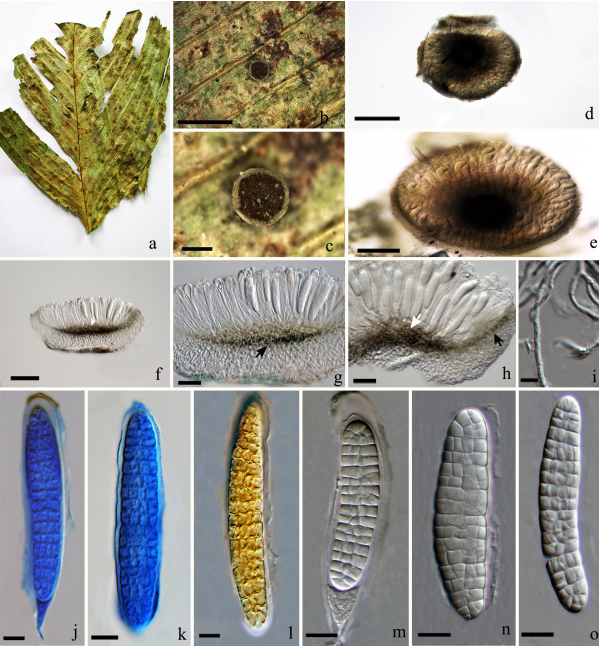
Calopadia ruiliensis a–c) Appearance of apothecia on lichen on leaves. d–e) Orbicular ascomata. f–h) Vertical section through apothecia with a developed basal layer. White arrows, black-brown pigment in subhymenium; black arrows, aeruginous pigmentation in hypothecium. i) Paraphyses. j–m) Bitunicate asci with ascospores. (j, k: in cotton blue; l: in Melzer’s reagent; m: in water.) n, o) Ascospores. Scale bars: b = 1000 μm, c–d = 200 μm, e–f = 100 μm, g–h = 40 μm, j–o = 10μm


